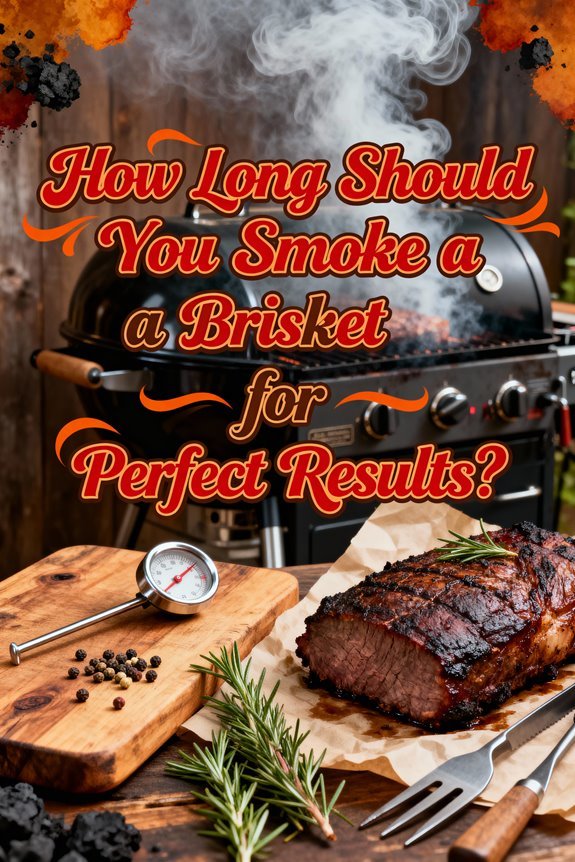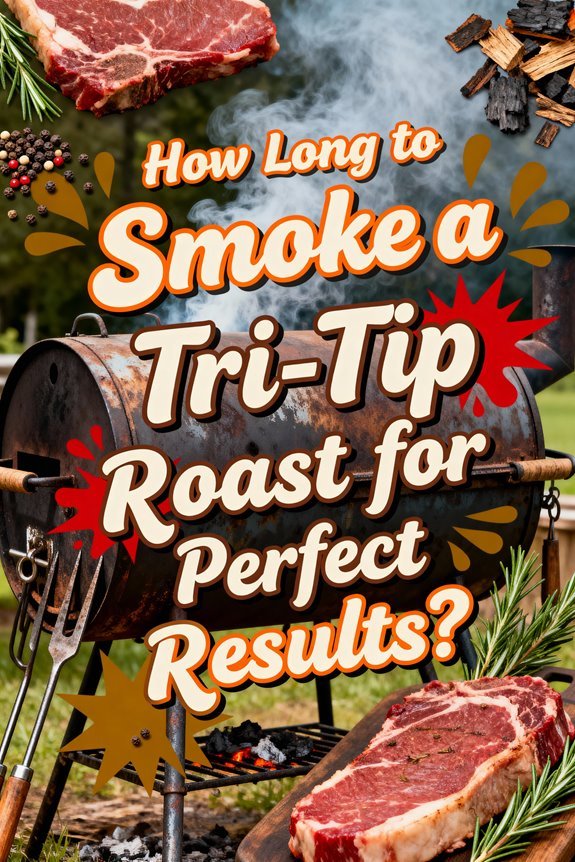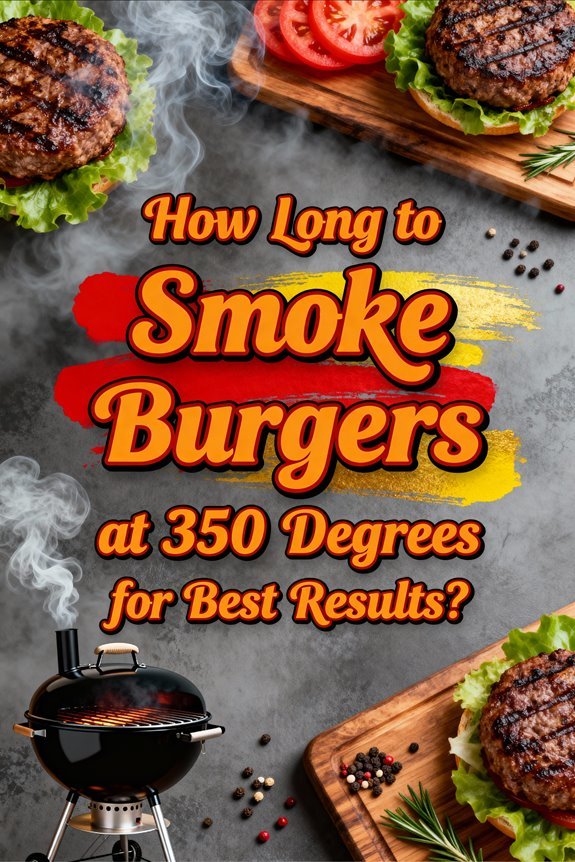You’ll need to smoke a brisket for 10 to 18 hours total, depending on its size and your smoker temperature. Plan on 1 to 1.5 hours per pound at 225°F to 250°F. A typical 15-pound brisket takes 10 to 14 hours of smoking, plus an essential 1 to 2 hour rest period before slicing. The infamous temperature stall around 165°F can add several hours to your timeline. Understanding the key variables and techniques below will help you master this process consistently.
Understanding the Basic Timeline: What to Expect When Smoking Brisket
When you commit to smoking a brisket, you’re starting on a process that demands patience and precision. Your cooking timeline depends primarily on weight—expect 1 to 1.5 hours per pound at 225°F. A 15-pound brisket typically requires 10 to 14 hours from start to finish. Low and slow smoking at 225°F helps break down tough connective tissues for maximum tenderness.
Your brisket preparation begins with trimming and seasoning, followed by preheating your smoker to consistent temperatures. During the initial smoking phase, you’ll spend approximately 8 hours reaching 165°F internal temperature for a 12-14 pound brisket. At this point, you’ll wrap it in butcher paper or foil. The meat may experience a temperature stall phase where progress slows due to evaporative cooling.
Continue cooking until the internal temperature hits 200-208°F. Don’t skip the essential 2-hour rest in a cooler—this allows juices to redistribute throughout the meat, ensuring ideal tenderness. Timing is crucial for each step to ensure the best results.
The Science Behind Temperature Phases and the Infamous Stall
As your brisket climbs toward its target temperature, it enters distinct thermal phases that directly impact the meat’s transformation. Between 160°F and 165°F, you’ll encounter the infamous stall—a period where internal temperature plateaus or even drops despite consistent heat. This phenomenon occurs as collagen denatures into gelatin while moisture evaporates from the surface, creating an evaporative cooling effect. The stall duration can extend beyond four hours, testing your patience but serving an essential purpose. During this phase, collagen’s conversion to gelatin accelerates, transforming tough connective tissue into tender, succulent meat. Temperature fluctuations during the stall are normal and shouldn’t alarm you. Maintaining your smoker’s consistent 225°F to 250°F range guarantees steady collagen breakdown while preserving moisture, ultimately delivering that sought-after tenderness when reaching 195°F to 205°F internally. Similar to smoked drumsticks, monitoring internal temperature with a meat thermometer is crucial for achieving optimal results. A resting period after cooking is essential to redistribute juices for enhanced flavor. Many pitmasters choose to add wood chunks for additional smoke flavor during the cooking process, with mesquite and oak being popular choices.
How Wrapping Methods Impact Your Smoking Duration and Bark Quality
Once your brisket hits the 150°F to 170°F range—typically six to nine hours into the smoke—you’ll face a critical decision that fundamentally alters both your timeline and final bark quality: whether to wrap, and if so, with what material. Butcher paper allows breathability, preserving bark texture while enhancing moisture retention. Foil seals completely, softening bark but maximizing juiciness. Both wrapping materials accelerate cooking by reducing evaporative cooling, shortening total time from 10-15 hours unwrapped to 8-12 hours wrapped. The Texas Crutch traps steam and rendered fat, speeding collagen breakdown for superior tenderness. For cooking consistency, double-wrap with paper and monitor probe resistance at 200-208°F. Before wrapping tightly, pour warmed tallow over the brisket to boost moisture and enhance the final texture. Unwrapping briefly before finishing re-crisps bark without extending duration considerably. Following the low and slow cooking method at 225°F ensures proper fat rendering and tender meat. A proper rest period of 1 to 4 hours allows the meat’s connective tissues to break down completely.
Choosing Your Smoker: How Different Equipment Affects Cooking Time
Your choice of smoker determines not just cooking duration but the entire thermal environment in which your brisket transforms. Direct heat smokers cook faster than traditional offset models due to efficient heat transfer, while offset smokers require 10-12 hours at lower temperatures with indirect heat circulation. Reverse flow offset smokers deliver 10-15% faster results through improved heat distribution via baffle systems. Much like low and slow smoking of chicken legs, pellet grills offer superior temperature control, enabling both hot-and-fast and low-and-slow methods depending on your settings. Similar to achieving crispy chicken skin, maintaining consistent temperature without frequently opening the smoker is crucial for optimal results. Pellet grills offer superior temperature control, enabling both hot-and-fast and low-and-slow methods depending on your settings. Size matters considerably—a 36″ smoker concentrates heat more effectively than an 82″ model, reducing cooking time for identical briskets. The fat to meat ratio of your brisket also influences how long it needs in the smoker, as higher fat content requires extended time for proper rendering and flavor development. Understanding these smoker types and their thermal characteristics helps you accurately predict duration and adjust your approach accordingly.
The Critical Role of Resting Time in Your Overall Schedule
While most pitmasters obsess over smoke rings and bark formation, they overlook the transformation that occurs after the brisket leaves the smoker—a resting period that fundamentally determines whether your 12-hour cook becomes a triumph or a disappointment.
Your brisket demands 1-2 hours of rest for muscle fibers to relax and redistribute juices throughout the meat. This resting duration directly impacts moisture retention—skip it, and you’ll watch precious juices pool on your cutting board instead of staying in each slice. Managing your smoker’s heat retention qualities helps maintain consistent temperatures during the cooking process, leading to more predictable resting times.
Wrap your brisket in foil and place it in a cooler to maintain temperatures below 160°F, preventing continued cooking while keeping it warm. During cooking, muscle fibers contract and push moisture to the center, which is why the resting phase becomes essential for redistributing those juices back toward the outer layers. Prime briskets with higher fat content can rest up to 16 hours, while leaner select cuts need just 1-2 hours. Build this window into your schedule from the start. Once properly rested, always remember to slice your brisket against the grain for the most tender eating experience.
Key Variables That Will Lengthen or Shorten Your Smoke
Before you schedule that rest period, you’ll need accurate timing for the smoke itself—and that number shifts dramatically based on factors within your control. Fat trimming reduces weight and improves heat penetration, shortening cook time. Brisket aging enhances tenderness and affects moisture retention, influencing duration. Meat conditioning—tempering to room temperature—accelerates even cooking. Smoker humidity from water pans slows evaporation while improving smoke absorption, extending the process but preventing dryness. Temperature fluctuations in traditional smokers prolong cooking compared to stable electric models. Wrapping during the stall halts evaporative cooling, cutting hours from your timeline. Opening the lid frequently bleeds heat, adding unpredictable delays. Larger briskets may actually finish faster per pound than smaller cuts due to more efficient heat distribution. A typical 3-pound brisket requires about 6 hours when smoked at 250°F for optimal results. Using butcher paper wrap during smoking helps develop a good bark while maintaining the meat’s moisture content. Track these variables closely—they’re the difference between a twelve-hour smoke and a sixteen-hour marathon.







